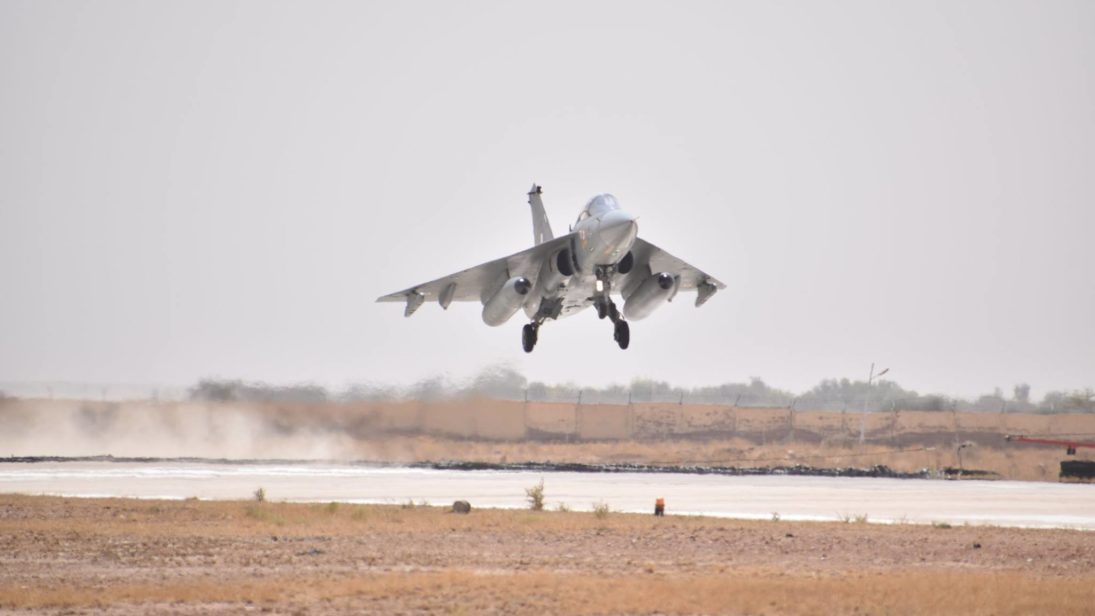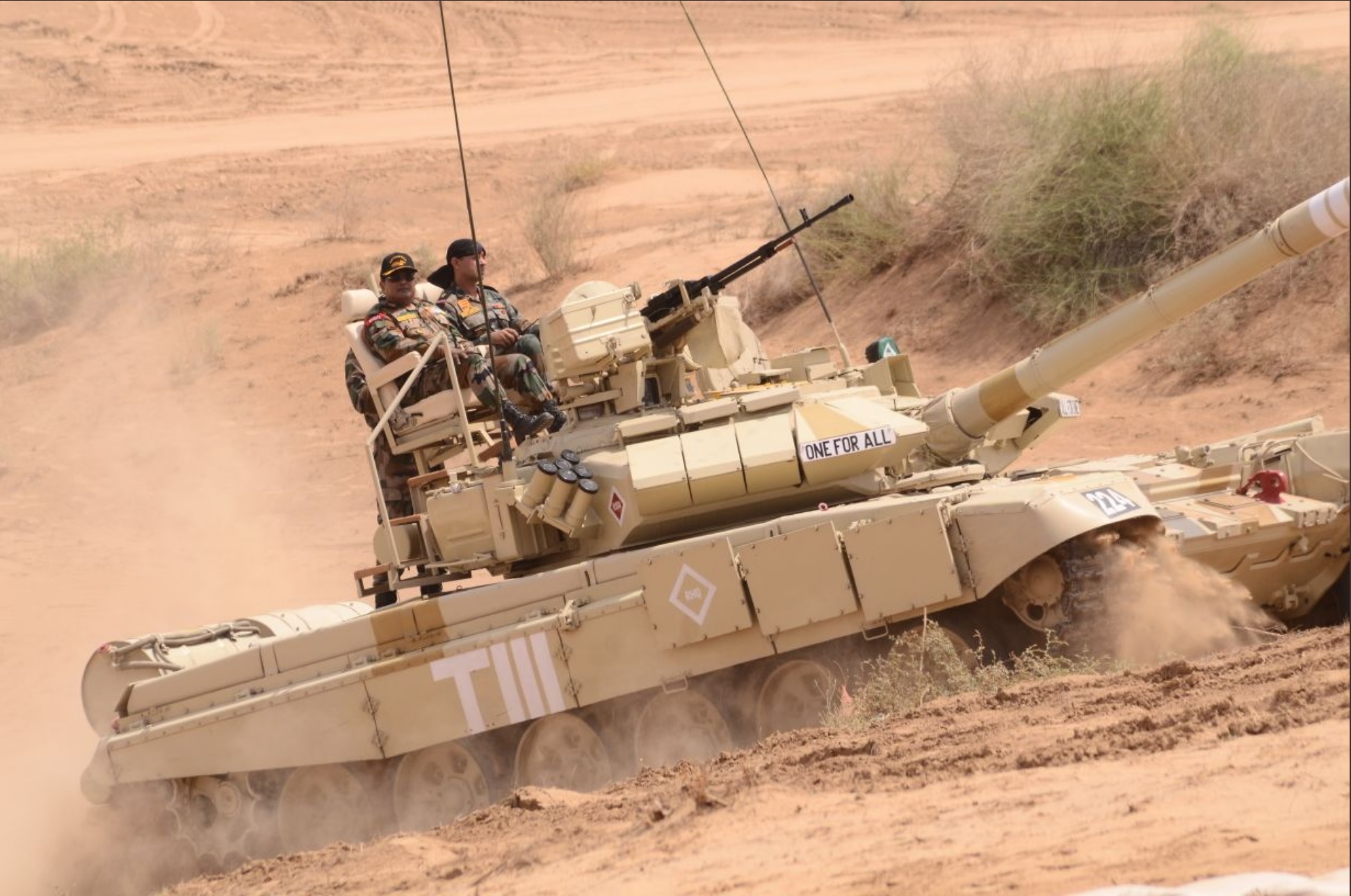
Three recent exercises undertaken by the Indian military suggest it may be gearing up for prosecuting war in the nuclear age: air exercise Gagan Shakti (Power of the Sky), reportedly the largest ever Indian Air Force (IAF) exercise; Vijay Prahaar (A Blow for Victory) carried out by Strike 1 Corps of the South West Command in the desert sector; and the South Western Command’s pivot corps, Chetak Corps’ Gandiv Vijay (Victory to Arjuna’s Bow). From the reports about these exercises in the press, it is not evident that these were based on a limited war doctrine, the deliberate pulling of conventional punches in cognizance of the nuclear threshold, that India espouses. In contrast, the military appears to be bracing for total war—that is, it is willing to countenance a war going nuclear—despite observing twenty years of the nuclear age on the subcontinent.
Battlefield Capabilities
Gagan Shakti
The scenario for Ex Gagan Shakti was a war on two fronts – along India’s border with Pakistan, and with China in the Indian Ocean region – which, in addition to the nuclear escalation potential of future conflicts, is perhaps India’s worst-case scenario. According to media reports, the air force shifted its sights from the western to the eastern adversary in quick time. It seems to have put the smaller neighbor’s air force out of action with offensive counter air and degradation tasks and, leaving that front to land forces, gone on to concentrate on the more difficult foe in the mountains. There were also long-range strikes across the Bay of Bengal for simulated interdiction of the Malacca Straits.
The scenario for Ex Gagan Shakti was a war on two fronts – along India’s border with Pakistan, and with China in the Indian Ocean region – which, in addition to the nuclear escalation potential of future conflicts, is perhaps India’s worst-case scenario.
Further into the exercise, there was also a mass casualty evacuation drill, presumably reflecting on the IAF’s capability for dealing with nuclear, chemical, radiological, and biological warfare contingencies. Incidentally, this was from the air base at Chabua in the north east, closest to the China border. This indicates that that the No First Use (NFU) pledge of either state did not quite hold up in this hypothetical conflict scenario. This portion of the exercise may have been more plausible if it was carried out on the western front, in light of Pakistan’s lack of an NFU doctrine and possession of battlefield nuclear weapons. Nevertheless, the lessons are valid for both fronts, and the IAF was able to express confidence in its capability to deal with nuclear, biological, and chemical attack scenarios.
Vijay Prahaar
The press release on Ex Vijay Prahaar reports that troops practiced “penetrative manoeuvres (sic) across the obstacle ridden terrain under a nuclear umbrella.” The formations of the Mathura-headquartered Strike 1 Corps, a potent offensive hammer under the Jaipur-based command, refined their drills and procedures for fighting in the nuclear environment. The air cavalry concept “aimed at reshaping land battle by defeating the enemy with an offensive punch from the air” was validated. Taking place immediately after Ex Gagan Shakti, Vijay Prahaar showcased jointmanship between the army and the air force in a future war scenario, where the IAF would handle the “enemy” in the air, as per the former exercise, while the army handles arms operations on the ground involving real-time information and deployment, as per Vijay Prahaar.
The Indian army’s advertisement of its ability to fight dirty suggests a turn to warfighting in a nuclear environment, a disconcerting comfort with total war.
A press release by the army informed of “deep thrusts… sustained effectively” and “continuing the offensive” through a capability for “fighting dirty.” However, the Pakistanis’ tactical nuclear weapons (TNWs) are meant precisely to deter these deep thrusts. Such thrusts can trigger TNW use, precipitating nuclear war. This suggests that the Indian military is unmindful of the nuclear threshold, rather complacent that nuclear deterrence would hold. The Indian army’s advertisement of its ability to fight dirty suggests a turn to warfighting in a nuclear environment, a disconcerting comfort with total war. This tendency is against the limited war concept, which must necessarily inform a conventional doctrine in the nuclear age.
Gandiv Vijay
For the past two months, the pivot corps of South Western Command, Chetak Corps, has also been engaged in a field exercise of its own—Ex Gandiv Vijay. The Corps’s Kota-based RAPID (Reorganized Army Plains Infantry Division) was its offensive component, reportedly practicing “multi-mode mobilization from dispersed locations to the time and place of decision in a terrain orchestrated on the lines of operational responsibility of the formation.” The exercise overlapped with Gagan Shakti and Vijay Prahaar, indicating a seamless war from pivot corps limited offensives setting the stage for strike corps breakout operations, all under an umbrella of offensive air operations.

Reinforcing Military Jointmanship
Applied together, the three exercises—each reinforcing jointmanship among the Indian armed forces—seem to integrate the army’s Cold Start Doctrine with the air force’s doctrine. While in Ex Gandiv Vijay, the pivot corps scrambled from a cold start to its battle locations, its RAPID division went on a limited offensive. At this time, perhaps, Ex Gagan Shakti’s phase one would play out, creating conditions for the “speedy depletion of the enemy’s combat potential” through “coercive strategies.” Thereafter, Ex Vijay Prahaar‘s Strike 1 Corps would be unleashed, passing over obstacles into enemy forces to knock out armored reserves reacting to the ongoing strikes. Alongside “swift offensive action”, Strike 1 will likely launch its Brahmos Block III cruise missiles, as practiced in 2017, in a “synergistic employment of long range vectors along with the Infantry and Mechanized Forces and the Air Arm to achieve a decisive victory.” Whether the nuclear deterrent would hold under the joint onslaught across a broad front – recall India has three strike corps and three commands facing west – puts a question mark on whether a limited war concept informs India’s military doctrine any more.
Moving Away From Limited War?
The land forces appear to be bent on making deep penetrations across obstacles and degrading the enemy’s reserves, thus flirting with both the territorial and degradation thresholds of nuclear first use.
While analysts argue that the armed forces are cognizant of “high-tempo and intense limited conflict,” these recent exercises do not lend confidence that India’s limited war doctrine will hold. In the cases considered, the land forces appear to be bent on making deep penetrations across obstacles and degrading the enemy’s reserves, thus flirting with both the territorial and degradation thresholds of nuclear first use. Recall both thresholds figure among the four that Khalid Kidwai, a former head of Pakistan’s Strategic Plans Division, had mentioned while Operation Parakram was on. Meanwhile, the air force takes the enemy on both over land and water, in reaction to a hypothetical, simulated setback, but absent escalation control mechanisms, both in place at the time of a real conflict and practiced during simulations, this horizontal escalation in real time can lead to potential nuclear outbreak.
Strategy is a two-way street. Gung-ho exercise-scenario-writing can be projected as a way to reinforce deterrence, showcasing India’s nuclear warfighting capability, thereby prevailing on Pakistan against taking a nuclear recourse because India has an answer to that too. However, it needs reminding that this cannot be done without also having robust nuclear risk management mechanisms in place to prevent and tackle escalation. India’s political authorities must put pressure on the military to clarify this. However, this is not happening as there is a disconnect, with the civilian side mistakenly believing that the doctrinal sphere is that of the military. This is not valid for the nuclear age.
Limited war is sine qua non in the nuclear age, or the only war that can plausibly be fought. India’s Cold Start Doctrine started out as a limited war doctrine, enabling conventional power application in a nuclear backdrop. This doctrinal concept must be reflected realistically in exercise scenarios. While exercises at the operational level are worst-case scenario-based and meant to demonstrate and validate capabilities – such as nuclear warfighting – the key strategic level takeaway from the aforementioned exercises is that offensive content in India’s doctrine militates against what the doctrine professes. To this end, India would do well to revisit the moorings of its military doctrines and reexamine if the limited war concept holds true.
***
Image 1: Indian Air Force via Facebook
Image 2: PRO Defence Rajasthan via Twitter


